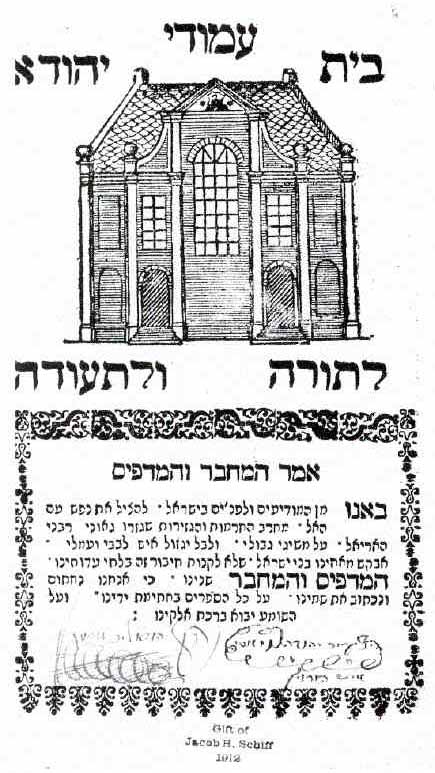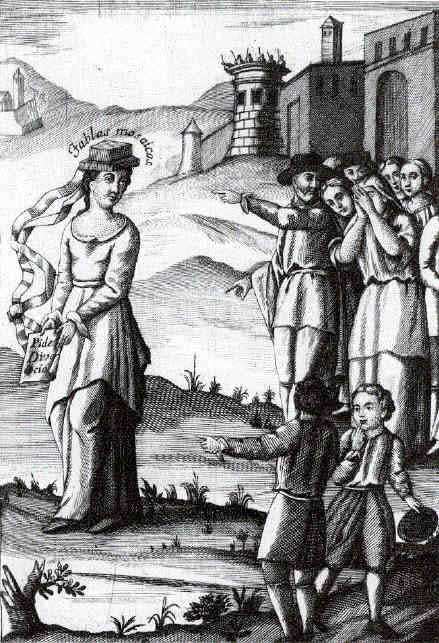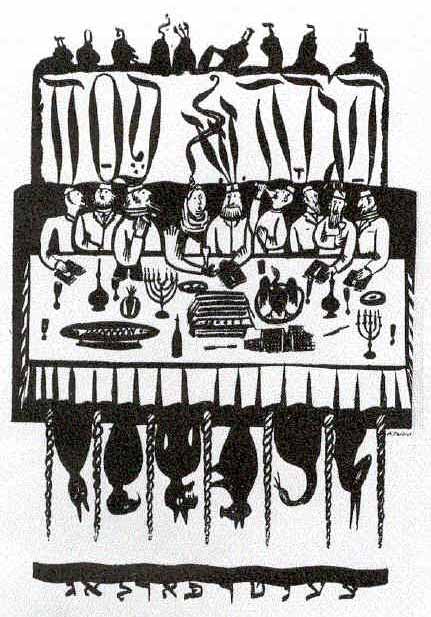A Choice Sampling
Witnesses to history, too, are some exotic morsels of
special interest to bibliophiles, historians, and collectors. Only Venice
might justifiably dispute the claim that Amsterdam was the greatest center
of Hebrew printing. The first book printed in Amsterdam would then be of
singular interest to bibliophiles. The colophon to Sefer Shvilei Emunah (Paths
of Faith), by Meir Ibn Aldabi, printed by Daniel da Fonseca, states:
"Praised be the Lord who gives strength to the weary ... who helped me
complete this heavenly work, first product of (Hebrew) printing in this
city." Authorities on Hebrew typography nonetheless award primacy to Seder
T'filoth K’Minhag K.K. Sefarad, a Sefardi prayer book published by
Menasseh ben Israel, which came off the press on January 1, 1627, a few
months before the Fonseca publication. it may well be that work on
Fonseca's book began first, but took a longer time to produce because of
the inefficiency of its printer. Its editor Abraham da Fonseca, found no
less than one hundred printer's errors! Daniel da Fonseca published only
one more book, while Menasseh ben Israel's press flourished for a quarter
of a century.
Some three dozen Hebrew books have appeared with the
notation that space was being left in each copy for the signature of the
author, editor, or publisher. One such volume, Sefer Amudei Bet Yehudah (The
Pillars of the House of Judah) Amsterdam, 1766, calls for the signatures of
both author and publisher. Both author and printer clearly ask purchasers
to buy only copies which have both signatures, yet most extant copies lack
the author's. The Library's copy has both that of author Judah ben Mordecai
ha-Levi Hurwitz, and of the publisher-printer Yehudah Leib Susmans. This
work also has the distinction of bearing the approbation of Moses
Mendelssohn, the only Hebrew book so honored.
To protect their investment, the author and publisher
of this work exhorted purchasers only to buy copies that contained both of
their signatures. Shown here is one of the copies bearing both signatures,
Judah Hurwitz, Sefer Amudei Bet Yehudah (The Pillars of the House of
Judah), Amsterdam, 1766. Hebraic Section, Library
of Congress Photo).
|
|
|
|
 |
Two books published 120 years apart, one in Amsterdam in
1687, the other in Mexico in 1807, are joined together by language. The
former, Seder B'rachot (Order of Benedictions), in Hebrew with a
Spanish translation, is a compendium of benedictions and liturgical
selections as well as some laws generally not found in the prayer book. Its
brief Hebrew introduction is a dedication to Isaac Aboab, a wealthy East
India merchant and a patron of rabbinical works, who was himself a scholar
and writer. Aboab's father fled from the Inquisition in Mexico and reverted
to Judaism in Amsterdam, taking the name Mattathias. Benjamin Senior
Godines, publisher of the compendium, found the house of Isaac Aboab
"filled with books; rare printed volumes, as well as
manuscripts," among them this work, which he calls in Spanish, Orden
de Benedictiones. The Spanish was intended for former Marranos or their descendants, who
were still not at home in the Hebrew language. The last two benedictions
are forms of memorial prayers, with places for the insertion of a name and
with proper pronouns for a man and for a woman "who was burned at the
stake for the sanctification of the Holy Name ... may the Lord seek
recompense for his/her blood, and visit retribution on the enemy."In Mexico, in 1807 the editor of La Gazeta, Don
Juan Lopez Cancelada, published a volume with some curious illustrations, Decreto
de Napokon ... Sobre Los Judios. One illustration accompanies an
account of divorce in Poland "en tiempo de Casimiro," i.e., King
Casimir the Great (1310-1370) the legendary protector and benefactor of the
Jews. The Jewish woman wears a headdress which seems to be a version of a
large phylactery. The four other illustrations are of Jews being tortured
by the inquisition.
In this illustration a Jewish woman wears a headdress
resembling a large phylactery, a Jewish ritual object which usually is
composed of two small square leather boxes containing slips inscribed with
spiritual passages and traditionally worn on the left arm and on the head
during morning weekday prayers, Cancelada, Don Juan Lopez, Decreto de
Napoleon ... Sobre Los Judios, Mexico, 1807. Rare Book and
Special Collections Division, Library of
Congress Photo).
 |
From the manuscript collection in the Library's Hebraic
Section, we call attention to two thick volumes of the classic of Lurianic
Kabbalah, the Sefer Etz Hayim of Hayim Vital; to a ledger of the
Jewish community of Mantua for the years 1784-96, which lists the
distribution of honors and contributions to charity; and to a collection of
prayers for Simhat Torah, Shavuot, and the ceremony of Brith Milah (circumcision).
Also included is a contingent decree of separation and support payments
issued in 1880 by the rabbinic court of Constantinople and endorsed and
countersigned by the Hakham Bashi (Chief Rabbi). Here the husband is
accused of cursing and abusing his wife, reviling her parents, and raising
his hand to do her harm. intermediaries attest that the husband has
promised to mend his ways but, in the meantime, he is obligated to support
her, even while they are separated. We find a report of the injury suffered
in 1809 by Rachel Cavalieri, who went up to the attic to watch a balloon
flight and fell off a chair. And, to end on a happy note, there is a doily
with a dedication to Rabbi Adolf Jellinek (of Vienna) on his seventieth
birthday, June 24, 189 1, inscribed by his student Zeev Wolf Sbrieser.
The company of collectors of Haggadot is large and
enthusiastic, and the Library houses a collection worthy of their
patronage. We cite a few of uncommon historic interest and a few which are
not what they seem. The first Haggadah with a French translation was
published in 1818 in Metz. Its translator is David Drach, rabbi, doctor of
law, a graduate of the Faculty of Letters of the Academy of Paris. He was
also the son-in-law of Rabbi Emanuel Deutz, the Grand Rabbi of France. Four
years later, Drach converted to Roman Catholicism and persuaded his
brother-in-law, the Chief Rabbi's son, to do likewise. In his later years
the latter returned to the Jewish faith but Drach remained loyal to and
active in his new faith—translating, editing, and writing. Among his
works are conversionary tracts and Hebrew poems in honor of the Pope and
Cardinals. For obvious reasons not many copies of his translation of the
Haggadah have survived.
In Vilna, in 1852 and again in 1860, editions of the
Haggadah were published with the commentaries of Zvi Hirsch of Grodno and
Jacob of Dubno "arranged according to the custom of Rabbi Elijah Gaon,"
but severely self-censored. The portion of "This is the bread of
affliction" that reads "this year we are slaves, next year we
shall be free," is altered to read, "this year we are slaves in
many places, next year we shall be free as we are in this our land."
The section, "Pour out thy wrath upon the nations which have not known
thee, and upon the kingdoms which have not called upon thy Name; for they
have devoured Jacob and laid waste his dwelling place" is completely
eliminated.
A takeoff on the traditional Passover Haggadah was
published in Moscow in 1927. Written by M. Altshuler, it attacked both
Judaism and Zionism, advancing the cause of international communism
instead. The cover shows a group of Jews partaking of the seder meal, while
hovering about them are ghosts, demons, and assorted inhabitants of the
spirit world, M. Altshuler, Hagodeh far Gloiber un Apikorsim (A
Haggadah for Believers and Atheists), Moscow, 1927. Hebraic Section, Library of Congress Photo).
 |
A Haggadah called Gufo shel Pesah, etc. (The
Essence of Passover or a Haggadah
for Jewish Tots), Berlin, 1830, in Hebrew and Yiddish, is not what it
purports to be, but is instead a missionary tract "published . . . to
rouse the hearts of Jewish children to seek the path of salvation."
Nor is the Hagodeh far Gloiber un Apikorsim, published in Moscow,
1927, for "Believers and Atheists," the Passover Haggadah. It, too is a
missionary tract, but of a different order. It proclaims, "May all the
aristocrats, bourgeois ... Bundists, Zionists ... Poale Zion ... be consumed in the fire of revolution.... May
annihilation overcome all the outdated rabbinic laws and customs." An
anarchist Haggadah published in New York in the 1890s is of a similar
nature.
The Haggadah Shel Pesah, printed in Munich, 1947,
is what it proclaims to be, a photo-offset edition of the traditional
Haggadah with an English translation. It was published and distributed in
Germany by the American Jewish Joint Distribution Committee for the
survivors of the Holocaust, who could now proclaim, "This year we are
free ... Next year, in Jerusalem."
Sources: Abraham J. Karp, From
the Ends of the Earth: Judaic Treasures of the Library of Congress,
(DC: Library of Congress,
1991).
|